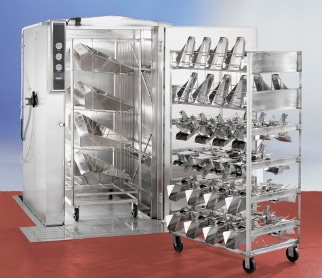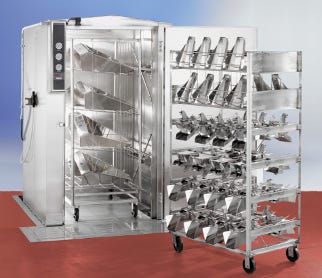March 11, 2015


Cross Contam Douglas
Although theories abound as to the cause, there is no arguing the effect: Food allergies are on the rise. Incidences of food allergies rose 18 percent from 1997-2007 among children under age 18, according to the most recent study published by The U.S. Department of Health and Human Services. The study estimates four out of every 100 children suffer from the ailment, and more than 90 percent of allergic reactions stem from eight food types: milk, eggs, peanuts, tree nuts, fish, shellfish, soy and wheat.
Thanks to the Food Allergen Labeling and Consumer Protection Act, food manufacturers are required to identify major allergens on food labels, or else risk recall. But following labeling protocol doesn't absolve manufacturers of risk. Food manufacturers who work with allergens must implement processes that eliminate cross-contact; in other words, where a food allergen contaminates a non-allergen containing product.
To help food manufacturers ensure the safety of an increasingly allergy-wary customer base, processing and packaging suppliers offer a variety of technologies to eliminate cross-contact concerns. Many of these will be showcased at PACK EXPO Las Vegas, running from Sept. 23-25, 2013, at the Las Vegas Convention Center.
A good clean
Improper cleaning poses one of the most significant risks for cross-contact. Fortunately, cleaning technologies have ramped up to meet the need.
"Proper tank cleaning is essential in preventing cross-contamination in food processing," asserts Alexandra Talarico, marketing coordinator for Gamajet (Booth #S-7533), part of the Alfa Laval Group. Its tank cleaning machines, featuring automated rotary impingement technology, eliminate the need to manually clean tank walls.
"Using this method will not only guarantee cleaner tanks but also require less time, water and other resources as compared with spray balls," adds Talarico.
Like Gamajet's rotary impingement machines, other cleaning innovations focus on increasing cleaning efficiency. Douglas Machines' (Booth #S-7618) automated washing systems are no exception. Among its varied product assortment, it offers Douglas Scale Parts Washers, roll-in batch washers used with specialized wash racks to clean buckets, feeder pans and chutes.
"Until recently, washing detachable scale parts from multi-head weighers has been a time consuming, hand-washing process that extended turnaround times, damaged parts and consumed too much labor, water, energy and chemicals." says Kevin Lemen, vp of sales and marketing. "Lately, food processors have turned to manufacturers of automated washing equipment to overcome these problems and help them better achieve today's higher standard of cleanliness and sanitation."
Designed for cleanliness
Designing with sanitation in mind is another way to control allergens. "Sanitary design of equipment is essential in preventing buildup and facilitating proper access for effective removal of allergen residues that can cause cross-contamination of food during production," says Rolando Gonzalez, vp of food safety for Bühler Inc. (Booth #S-7140).
With this objective in mind, Bühler has developed the Sanimix mixer, a welded stainless-steel design with self-discharging trough geometry and a full-width discharge door that eliminates crevices and areas that could harbor materials. Used for specialty mixes that incorporate a range of ingredients, including liquid and solid fat, the design ensures thorough cleaning.
Although contamination can happen anywhere, Lori Costa, sales and marketing manager for Stainless Motors Inc. (Booth #S-7637) says that during sanitation procedures, "specific attention should be given to equipment that is in contact with food containing allergens. For instance, a conveyor-along with its operating motor-that moves food can lead to unintentional allergen cross contamination if hidden surfaces or niche areas are not thoroughly cleaned."
Helping processors avoid problems, Stainless Motors will showcase its patent-pending Sanifan Technology stainless steel motor at PACK EXPO, available in dry design and wet design versions.
In addition to various gaps and crevices, conventional motors use molded plastic fans with blind pockets, where allergenic debris can accumulate and eventually become airborne, explains Lori Costa, sales and marketing manager. She adds, "Sanifan Technology stainless steel motors with smooth, polished stainless fans are designed with a niche-free environment and provide a means to allow previously inaccessible areas in the fan, endbell and fan shroud to be thoroughly washed of allergenic material."
To meet the needs for sanitary machine design, inch- and metric-size component supplier J.W. Winco (Booth #s-6240) offers many components suitable for food processing and packaging applications. The company's GN 5339.5 stainless steel triangular knobs feature smooth and enclosed areas, as well as corner radaii, that comply with hygiene requirements. Meanwhile, the GN 565.5 stainless steel handles have no hollows in which debris might collect.
The Chain-Vey tubular drag conveyor, from Modern Process Equipment Corp. (Booth #S-7058), is also created to make sanitation easy.
"This chain and disc technology gently moves product, virtually eliminating degradation and particle size declassification, thereby making it an optimal solution for hundreds of products, including ground coffee, dried foods, material chips and more," says Lizzie Ephraim, director of marketing. Among its benefits, the technology boasts an optional self-cleaning feature and an enclosed, sealed tube that protects product aroma and the surrounding environment.
Proof in the process
It's not just about cleaning. Avoiding cross-contamination involves following effective processes, too. These can vary depending upon application.
In powder production, for example, where most items are made in batches, food processors are wise to promote a system that maintains batch product integrity. Matcon USA (Booth #S-6937) specializes in filling and emptying stainless steel containers used as portable batch vessels. The easy-to-clean containers, coupled with powder transfers completed in a closed loop, are used as a part of a process that's "specifically geared toward environments where there are contamination concerns due to allergens," says Dan Ruble, vp of sales and marketing.
For chocolate molding, the use of allergen-containing rework is another area where food cross-contaminates. To eliminate this possibility, Sollich KG's (Booth #S-7701) Reworktemper provides re-tempered rework mass directly to the mold plant hopper, which avoids possible allergen contamination of the main chocolate supply tanks, where rework has been traditionally reintroduced.
No matter what the specific application, all food processors should take the possibility of allergen cross-contact seriously. Several companies provide software to aid in the managing of allergens across operations.
"Manufacturers, packagers and the systems that support them need to look at the cross-contamination possibilities all the way from the planning and scheduling, through production staging, production and line clearance/reconciliation," says Mehran Malek, vp of client services for Nulogy (Booth #S-7403). The company's flagship PackManager software, a cloud-based, end-to-end system, is designed to handle cross-contaminations, among other industry complexities, such as traceability. Nulogy continues to explore ways to meet industry needs, and is in the process of developing smart scheduling of product categories that must obey specific cross-contamination rules.
To help its customers avoid allergen cross contamination across operations, Plex Systems (Booth #S-7139) will showcase at PACK EXPO the core functionality of Plex Online, which includes the Plex Online Cloud Enterprise Resource Planning production module and the integrated Plex Online Food Safety Management System.
Making it easy to systematically enforce industry best practices, Plex Online's functional coverage includes inventory attribute tracking and control, production management, and integrated bar coding and labeling.
"The supply chain for food and beverage processors continues to become more global, complicated and extended," says Tom Nessen, solution engineer and manager, food and beverage, Plex Systems. "With the assistance of an automated system for recordkeeping, product verification and employee training, effective cross contamination avoidance can become a part of normal operations."
This year, PACK EXPO Las Vegas 2013 will be the go-to resource for the latest industry trends and innovation. Attendees can address their food safety concerns with subject matter experts at the Food Safety Summit Resource Center sponsored by GE Intelligent Platforms (Booth #S-7332). The feature will return to PACK EXPO to shed light on the impact of new legislation with Food Safety Modernization Act (FSMA) and help manufacturers determine solutions for compliance.
Bühler Inc., 763-847-9900
www.buhlergroup.com
Douglas Machines Corp.,
800-331-6870
www.dougmac.com
Gamajet, part of the Alfa Laval Group, 877-426-2538
www.gamajet.com
J.W. Winco, 800-877-8351
www.jwwinco.com
Matcon USA, 309-523-3774
www.matconusa.com
Modern Process Equipment Corp., 773-254-3929
www.mpechicago.com
Nulogy, 888-685-6491
www.nulogy.com
Plex Systems, 248-391-8001
www.plex.com
Sollich KG, +49 52.22.95 0-0
www.sollich.com
Stainless Motors Inc.,
505-867-0224
www.stainlessmotors.com
.
You May Also Like


